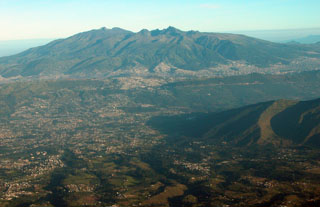Report on Guagua Pichincha (Ecuador) — February 1999
Bulletin of the Global Volcanism Network, vol. 24, no. 2 (February 1999)
Managing Editor: Richard Wunderman.
Guagua Pichincha (Ecuador) Moderate seismicity and phreatic eruptions during January-February
Please cite this report as:
Global Volcanism Program, 1999. Report on Guagua Pichincha (Ecuador) (Wunderman, R., ed.). Bulletin of the Global Volcanism Network, 24:2. Smithsonian Institution. https://doi.org/10.5479/si.GVP.BGVN199902-352020
Guagua Pichincha
Ecuador
0.171°S, 78.598°W; summit elev. 4784 m
All times are local (unless otherwise noted)
The Instituto Geofísico (IG-EPN) monitors seismic events, crustal deformation, geochemistry, and records visual observations at Guagua Pichincha. This volcano consists of a 2-km-wide caldera, breached to the west, on whose floor lies a dome complex and the present explosion craters. The following report summarizes their daily observations from 1 January to 31 March 1999. During this period, a Yellow alert status persisted.
Bad weather often prevented or hindered visual observations. Guards at the refuge station and visiting scientists frequently reported noises and the strong smell of sulfur from the fumaroles. COSPEC data from 16 January and 13 March showed only background concentrations of SO2 from the fumaroles, following the maximum concentrations yet recorded (170 t/day) on 10 December. Ash-and-steam plumes from dome fumaroles, when visible, ranged from 100 to 800 m in height, while explosion plumes reached 3 km. The 1981 explosion crater had increased in diameter and almost absorbed the September 1998 crater.
People living along the Cristal river (W flank) confirmed the seismic detection of small debris flows and floods that were generated on 7 and 27 January, 2, 16, and 21 February, and 1 March, all related to intense rainfalls; these traveled down the Rio Cristal at least 10-15 km. Estimated volumes are between 0.3 and 1 x 10-6 m3 with estimated peak discharges of 100-250 m3/s.
Phreatic explosions covered the dome and the interior of the caldera with ash and rocks. A guard at the refuge station and Civil Defense personnel found 2-5 mm of new ash and new impact craters in the Terraza area following the explosions of 21 and 23 January. Analysis of the ash showed no juvenile material, suggesting that magma had not ascended. Ballistically ejected rock fragments up to 30 cm in diameter were found 1-1.5 km S and SE of the dome, the result of phreatic explosions in this time period.
Volcano-tectonic (VT), long-period (LP), and hybrid earthquakes, sometimes in multiples, occurred almost daily throughout January, February, and March. Phreatic explosions were frequent during that period, occurring on average once per day in February and March. Daily LP event counts varied between 1 and 40, but many days had few VT or LP events. Still, 24 VT events occurred on 28 February and 1 March. .High-frequency tremor episodes of a few minutes to as much as four hours (9 February) duration were recorded, but possible associated effects in at the caldera summit could not be confirmed due to bad weather. Some rockfalls in the caldera were heard by the refuge guards while tremor episodes were occurring.
On 9 February and 14 March instruments detected 16 and 70 tectonic earthquakes along the N part of the Quito fault. The largest events had magnitudes of 3.7 and 4.0, respectively. It had been speculated that these events represented sympathetic responses to stresses produced by the volcano's magma chamber. This idea came from an earlier observation of an "on-off scenario" where the presence earthquakes in the N Quito area correlated with little seismicity registering under the caldera, and vice versa.
Reduced displacement measurements (RDs) of phreatic explosions ranged from those too small to measure to several that were 20 cm2 or greater. Some of these larger RDs, such as those on 18 and 28 January, and 13, 19, and 28 February, were the largest since October 1998. The one on 28 February was the largest yet recorded. A summary of seismic events since August 1998 is presented in table 2.
Table 2. Monthly summaries of explosions and seismic events at Guagua Pichincha, August 1998-March 1999. Courtesy IG-EPN.
| Month | Phreatic Explosions | Volcano-tectonic | Long-period | Hybrid |
| Aug 1998 | 8 | 23 | 18 | 29 |
| Sep 1998 | 24 | 73 | 165 | 1,626 |
| Oct 1998 | 25 | 49 | 191 | 1,448 |
| Nov 1998 | 18 | 52 | 234 | 419 |
| Dec 1998 | 7 | 59 | 94 | 166 |
| Jan 1999 | 18 | 41 | 218 | 1,163 |
| Feb 1999 | 28 | 60 | 190 | 2,099 |
| Mar 1999 | 21 | 115 | 73 | 940 |
Geological Summary. Guagua Pichincha and the older Pleistocene Rucu Pichincha stratovolcanoes form a broad volcanic massif that rises immediately W of Ecuador's capital city, Quito. A lava dome grew at the head of a 6-km-wide scarp formed during a late-Pleistocene slope failure ~50,000 years ago. Subsequent late-Pleistocene and Holocene eruptions from the central vent consisted of explosive activity with pyroclastic flows accompanied by periodic growth and destruction of the lava dome. Many minor eruptions have been recorded since the mid-1500's; the largest took place in 1660, when ash fell over a 1,000 km radius and accumulated to 30 cm depth in Quito. Pyroclastic flows and surges also occurred, primarily to then W, and affected agricultural activity.
Information Contacts: Instituto Geofísico, Escuela Politécnica Nacional, Apartado 17-01-2759, Quito, Ecuador.

